20 Tactics to Boost Your Digital Marketing Strategy
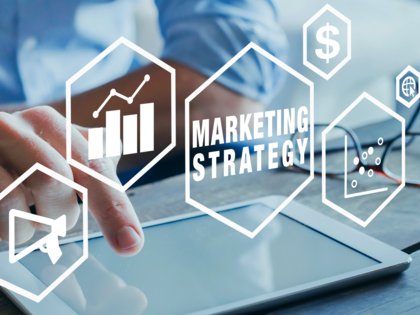
- Summary
- 1. Build a Customer Persona
- 2. Create a Blog
- 3. Build a Website
- 4. SEO (Search Engine Optimization)
- 5. Social Media Marketing
- 6. Paid Social
- 7. Leverage Influencer Marketing
- 8. Utilize Email Marketing
- 9. Think About VSO (Voice Search Optimization)
- 10. Try Video Marketing
- 11. Start a Podcast
- 12. Host a Webinar
- 13. Get on Google Maps
- 14. Be Local
- 15. Run Giveaways
- 16. SMS Marketing
- 17. Content Marketing
- 18. Brand Partnerships
- 19. Affiliate Marketing
- 20. Partnering with the Right Digital Agency
A digital marketing strategy is a roadmap of specific goals that help your organization attain specific goals through online channels. Running a digital marketing campaign without a strategy in place is much like navigating an unfamiliar city without GPS – an inevitable wrong turn leads to both frustration and an unnecessarily longer route to your final destination.
When you are planning a trip, you probably begin by developing an itinerary to ensure you make the most out of your time and budget. The same goes for digital marketing, a marketing plan is necessary for increased efficiency.
Of course, planning the ideal digital marketing strategy isn’t as easy as asking Siri where to go. But there are important steps that can be taken to guide you on your travels.
As a top-tier digital marketing agency, let’s break down 20 digital marketing tactics that can set your digital marketing strategy on the right path toward increased sales (and profits).
1. Build a Customer Persona
Unless you’re a confirmed introvert, one of the most enjoyable parts of traveling is meeting new people. But issues like language barriers may make your choice of destination more limited. If the locals don’t speak your language, you either need to be a lightning-quick learner, a new destination, or a translator.
In other words, you need to know what you’re getting into and have a plan for handling difficulties.
This also goes for marketing. As a digital marketer, you need to know exactly who your audience is - and how to talk to them.
You need to identify your company’s unique buyer personas.
Who Are My People?
Now that we’ve beaten the travel analogies to death, let’s get to work.
When you’re formulating a digital marketing strategy, the first big question to ask is which people are interested in your product or service?
Buyer Personas are detailed fictional descriptions of those who represent your target audience. They’re based on deep research of your existing or desired audience.
Have you had proven success with a certain group of individuals? Great, target them.
Are you looking to expand to new audiences? Do the research. Identify them. Be specific. Skip the stereotypes and look into factual insights through readily available tools like Facebook Audience Insights and Google Analytics.
You can begin to describe these personas with basic background information such as job title and location. How old are they? What’s their financial situation? Do they have children? What motivates their buying decisions?
You’ll also want to determine what this person wants, such as a solution to a specific problem (a problem your business can solve!).
If we’re talking about B2B, what’s the size of the company? Who makes the buying decisions?
Next, determine the best way to reach this persona. Where do they live in the digital world?
Who Should Do This?
Everyone. If you don’t know who you’re talking to, you don’t know what to say.
What Does it Look Like?
A good buyer persona lets you visualize and get inside the head of specific segments of your target audience. Give them a name. What’s their job? How much do they make? What are they looking for when they need a product or service like yours?
When you’re done, you’ll have something that looks like this:
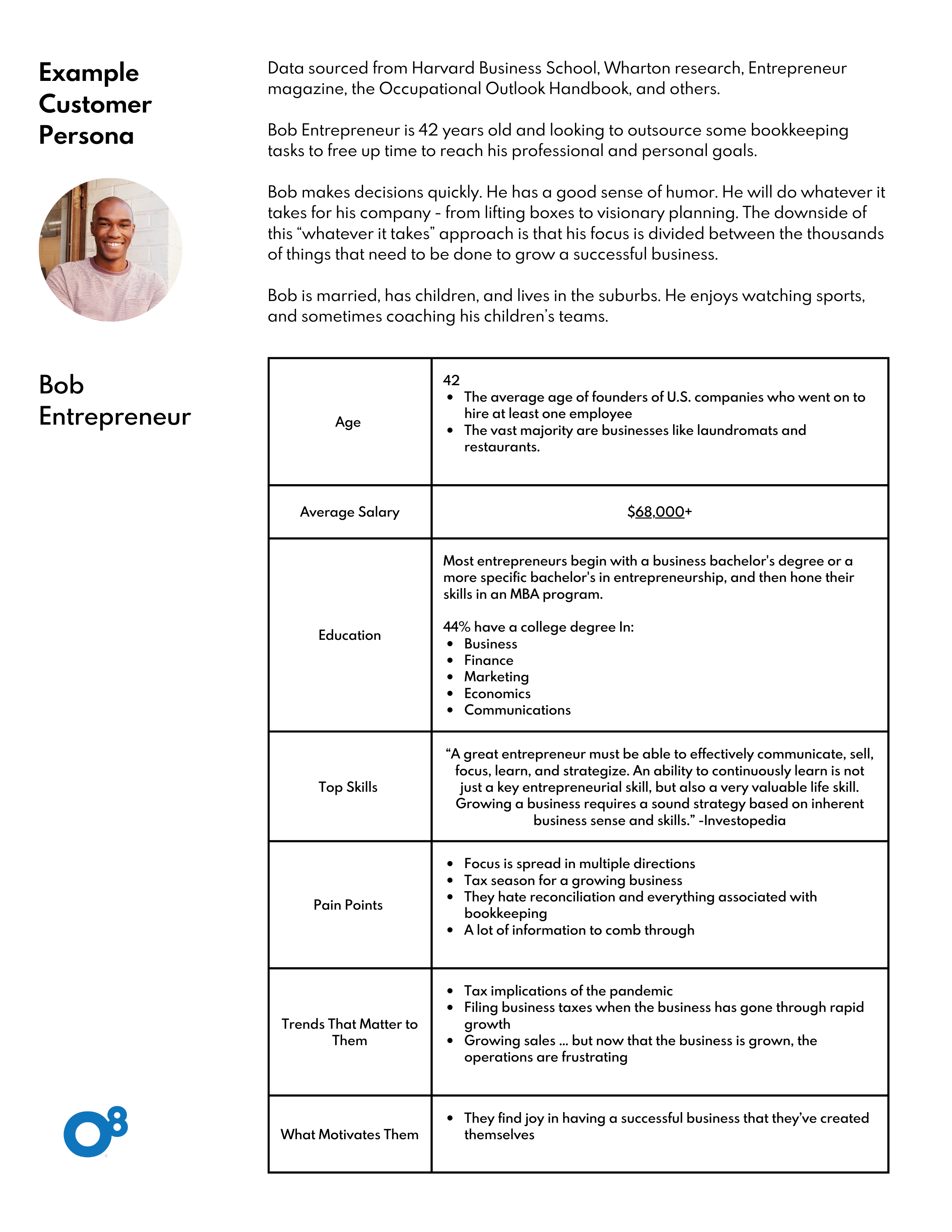
The Why
Think of a buyer persona like a profile on a dating site. The more you know, the better your chances of making an impression when you send that first DM.
When it’s time for you to create content, send emails, and engage on social media, - think of it almost like asking your prospective buyers on a date. Gathering insights on preferences and general attitudes always makes for a better experience. It’s these insights that help you best tailor your message and goals.
2. Create a Blog
Now that you know who you’re talking to, you need to say something of value. Give them a need and reason to explore your website. Rather than sending a shot in the dark and crossing your fingers that it resonates, create pillars of content that capture and engage.
While there are several ways in which you can connect with your previously identified buyer personas through quality content, one of the most common and effective channels to distribute this content and support your marketing strategy are blogs.
We’ve all seen them. We’ve all read them. You might have even written one. If you’re doing business in today’s digital environment, maintaining a blog is no longer just an option, it’s a necessity.
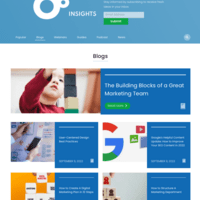
The Benefits of the Blog
Vast numbers of people worldwide make their way through the highways and side streets of the web daily. According to Statista, nearly 4 billion people are currently connected. You can be certain that many of those people match your buyer persona profiles, and they’re all looking for a good reason to stop and browse through your website.
Here are some of the most important things a blog can do to bring all those eyes to your site:
-
Drives traffic to your website: Every time you publish a blog post, it adds one more indexed page to your website. More indexed pages mean an increased chance of your site finding its place on the search engine results page (SERP). And that drives traffic to your website. New content is a cue to Google and other search engines that your website is active. And, as a result, they’ll check in more frequently to catch new updates.
-
Establishes you as an authority: The web is an unprecedented repository of pure information. When a consumer is making a buying decision, they surf that repository for reliable information to inform that decision. A well-curated blog establishes you as an expert - and makes your website a reliable source of the information your prospective customers need.
-
Ready-made content for social media: We’ll discuss the importance of social media later. Suffice it to say for now that it’s not sufficient to have a social media presence. You’ve got to engage with your social media audience on an ongoing basis. Not everyone relies on Google to find information. They look to social media. And blog content makes for a ready-made social media post that drives people to your website for more information.
-
Converts traffic into leads: Blogs aren’t simply a source of information. Each blog that you post should include at least one call to action link or button to lead viewers to content like free ebooks, whitepapers, fact sheets, webinars, trials, and more. A good call to action will lead otherwise passive viewers to contact pages where they’ll happily exchange their information to access the assets listed above. And just like that, you’ve created a wealth of new leads.
-
Link building: The Google algorithm considers as many as 200 factors when ranking your site on its result page. Inbound links or backlinks are one of those important factors. Backlinks are a crucial factor in search engine optimization.
3. Build a Website
It’s been years since having a website for your business has been optional. Building a functional and beautiful website is a must for any business. Your website is a hub for all online channels and your main point of contact. The best website design should send a message about who you are and demonstrate a level of professionalism and expertise. It’s often the first exposure prospective customers are going to have to your company.
Quite simply, if you want to do business, you need a landing page from which all that website traffic can take off and take flight on its trip through your overall digital presence.
Here are just a few of the ways a website can significantly benefit your business:
-
Credibility: We’ll say it again: a good website demonstrates your professionalism. Consumers today expect a company to have a website. Having a website gives your company credibility - or more accurately, not having one casts doubt upon your credibility in a world where everyone worth doing business with has an online home.
-
Brand awareness: A website helps create brand awareness. It’s a showroom that presents your brand to prospective customers. And unlike a physical showroom, you can exercise much more control over the shopping or browsing experience. It also lets your audience know who you are and what you represent. Your website provides customers with reliable information that sets your business apart from the competitors.
-
24/7 customer service: Customers, both current and prospective need answers - and they aren’t always looking for them during business hours. From simple questions like the address or hours of operation etc. to more detailed questions about your products, if the answers aren’t available when the customer needs them, they’ll move on to someone else. A well-designed website can help boost customer experience by providing answers around the clock. And dynamic user interfaces make for enhanced end-user interaction beyond just displaying generic content.
-
Attracting organic traffic: Through the magic of SEO optimization of your site as well as content like that blog that we discussed above, the likelihood increases that you’ll rise to the top of the Google search results page. From there, prospective customers who are specifically searching for products or services like yours are just a click away from your digital front door.
-
Lead generation: Once they’ve found you and clicked that link, it’s time to generate leads and increase sales. We talked about this in the blog section above. The more content you can add that will lead traffic to those CTAs, the more you can generate leads and drive sales to where you need them to be.
-
A digital destination: Finally, a well-made website serves as a destination that can be reached via all of your digital marketing efforts.
4. SEO (Search Engine Optimization)
Everyone talks about it, but what exactly is it?
To quote Hubspot, “SEO stands for search engine optimization... It refers to techniques that help your website rank higher in search engine results pages (SERPs). This makes your website more visible to people who are looking for solutions that your brand, product, or service can provide via search engines like Google, Yahoo!, and Bing.”
Every time you publish a blog post, it adds one more indexed page to your website. More indexed pages mean an increased chance of your site finding its place on the search engine results page (SERP). And that drives traffic to your website. New content is a cue to Google and other search engines that your website is active. And, as a result, they’ll check in more frequently to catch new updates.
The way to accomplish this is to pack your blog posts (and the rest of your site) with keywords that match the words that prospective customers are using when they take their search to the web. By choosing optimal SEO keywords, you are taking advantage of the algorithms used by popular search engines, and increasing your traffic as well as your ROI (return on investment).
Get more leads and insights from your website today
5. Social Media Marketing
A strong social media presence is a key building block for a reliable brand. It helps you stand out, and makes it easier to gain traction with potential customers. If your business is primarily online, you need to have a strong social presence.
It’s also true, though, that as many as 43% of consumers always search for a brick-and-mortar business online before visiting for the first time. Not only that but 1 in 4 shoppers are unlikely to visit a business they can’t find online. This, of course, underlines the need for a well-designed website, but it’s also true that more and more consumers are relying on social media to gather information about you - and to find that website.
All companies can benefit from a social media marketing strategy, but especially for small businesses that lack the credibility of being a household name, building a foundation on social media platforms is especially crucial.

Some benefits of harnessing social media marketing include:
-
A direct connection with your audience: The beauty of social media is that it functions as a community. It’s a two-way street. Instead of just tossing content into the waters and hoping someone bites. Social media allows you not just to communicate with your audience, but to communicate with your audience - and for them to communicate with you.
-
Large audiences: Social media platforms are a great opportunity for your business to reach vast numbers of people who are already interested in what you have to offer. Pew Research Center reports that the percentages of U.S. adults using social media are:
-
YouTube: 73%
-
Facebook: 68%
-
Instagram: 35%
-
Pinterest: 29%
-
Snapchat: 27%
-
LinkedIn: 25%
-
Twitter: 24%
That’s a huge number of prospective customers just waiting to hear from you.
-
-
Brand building: When you connect with leads on social media, you expose them to your brand, and the ability to easily post content helps build brand recognition repeatedly in a way that is not only informative but timely. It’s all about brand loyalty. The more you expose people to your brand, the more familiar they become with it - and people tend to buy from brands they know well.
-
Going viral: People on social media love to share. That’s why they call it “social” media. By creating content that speaks to your followers, you’re also creating content that those followers will want to share with their friends. And those friends will share. And their friends will share via word of mouth. The opportunity to “go viral” with your social content is a free multiplier that can increase your reach exponentially - at no additional cost.
-
A pipeline to your website: It’s not just about increasing attention and familiarity with your product, though. The ultimate goal is to convert those followers into customers, and you do that by making it easy for them to connect to that great website that you’ve already created where they can learn more, schedule appointments, and even make purchases.
-
Free to join the fun: Put simply, it costs you nothing to join the social fun. There are no signup fees of any sort for most of the largest platforms. your only investment is time.
Of course, there are also paid advertising options on most social media platforms. We’ll talk about those next.
Social media campaigns do require skill, and a well-thought-out strategy needs to be in place. Also, they need an interactive and responsive approach with dedicated resources and the right level of management/oversight that is appropriate for your organization.
Fortunately, we’re here to help.
6. Paid Social
One of the greatest advantages of social media is the ease with which you can create organic content and an online presence that costs you nothing but reaches vast audiences. But you also have the option of opening your wallet for Paid Social.
“Paid social,” simply put, means social media ads on social networks. We’re talking about sponsored, paid advertising on social channels. It’s a way to get more eyes on your brand through ads targeted toward custom audiences.
Why is a Paid social media strategy a useful option for digital marketing? The answer is simple: wider reach, more visibility, enhanced brand awareness, in-depth market insights, and targeted advertising.
Let’s look at some options:
-
Facebook ads: Facebook and other social platforms collect a great deal of data on their users. That’s data you can use when targeting their audiences. You can specify the demographics like gender, location, and age. But you can also target based on options, like interests, purchasing behaviors, education and job history, income, political affiliation, major life events, and spoken languages.
How much does it cost? According to WordStream, a study of Facebook Ads performance for its 256 US-based clients resulted in many helpful performance benchmarks, including an average click-through rate of 1.04% and an average cost per click of $1.27.
-
Instagram ads: Instagram advertising costs between $0.20 to $6.70 on average, depending on the bidding model. CPM, or cost-per-impressions run at $6.70 per 1000 impressions. CPC or cost-per-click goes for $0.20 to $2 per click. For CPE or cost-per-engagement, you’ll pay $0.01 to $0.05 per engagement.
-
Twitter ads: Twitter may not be the most dominant social media platform - they boast 206 million daily active users while Facebook claims 1.93 billion - but on Twitter, it’s easier to spread your message via comments and retweets. It’s still an attractive advertising vehicle. Twitter’s average CPM (Cost Per Million) is around $3.50 compared to Facebook’s $0.59. Arguably, though, you’ll spend significantly more with Facebook to get the same kind of engagement and click-through rate (CTR). With that in mind, Facebook may be more expensive in the long run.
-
LinkedIn: LinkedIn boasts over 690 million members. Out of those users, four out of five have the power to impact business decisions. They also have 2x the buying power of typical online audiences. Just sign into Campaign Manager, choose your objective, define your target audience, choose your ad format, set your budget, set up your ad creative, and save your billing information. Here’s a handy tutorial.
-
TikTok: 1 in 2 Gen Z TikTok users are likely to buy something while using TikTok, and 81% of their users use TikTok to discover new products and brands. Plus TikTok video ads take up 6x more screen real estate than banner ads.
-
Pinterest: Pinterest can deliver 400 million people per month who use Pinterest to discover and buy products. Learn how to reach that audience here.
-
Google ads: Google Ads is Google’s paid online advertising platform (Originally called Google Adwords). Essentially, when users search for a keyword, they’re presented with a search engine results page (SERP). The results on this page often include one or more paid advertisements that targeted that keyword. These paid ads appear at the top of the search page - and top-of-page results on Google typically get the vast majority of the traffic. Learn more here.
7. Leverage Influencer Marketing
Influencer marketing began with bloggers sharing stories about their lives while also promoting products they used and liked. It was 2006, and Facebook and Twitter were the new kids on the block. In 2010, Instagram joined the party. It wasn’t long before brands realized they could promote their products (especially now on Tik Tok) through these endorsements from influencers and content creators.
Today, social media, blogs, and podcasts are where you’ll find the majority of influencers. Influencer marketing often plays the role of brand awareness campaigns. This presentation of brand credibility, social proof, and confidence also often results in a wealth of conversions and sales.
When it began, any money made by influencers was little more than a little cash on the side. In time, though, more and more of them began earning a living through brand sponsorships as career influencers.
There are a few good reasons why you should leverage the power of social influencers when planning your digital marketing strategy, especially as a startup. At the moment,
-
9 out of 10 brands are taking advantage of influencer marketing in one form or another.
-
Because of the significant growth in active influencers, there’s bound to be an influencer out there who meets your specific needs.
-
Influencers generate an earned media value of $18 for every $1 spent.
-
Influencer marketing is particularly effective for businesses targeting B2C and younger crowds.
Take the example of Glossier and its massive rise to success. While there are a number of contributing factors, the brand that began in 2014 took flight due to massive influencer marketing success. In the beginning, Glossier was built on social media buzz, enlisting influencers like Amy Serrano, flying her to New York to participate in a curated glossier experience. From there, more and more influencers got involved, and the brand began to grow exponentially. The key here is knowing your niche and how influencer content best connects with them.

8. Utilize Email Marketing
Email marketing is a marketing channel that has survived the test of time, the rise and fall of more trendy channels, and countless predictions of its demise. It would be easy to dismiss email as out of date or passé but underestimate it at your peril.
Email marketing is the most profitable and cost-effective direct marketing channel out there to the tune of an average return on investment (ROI) of $42 for every $1 spent.
Despite the popularity of all the flashy social media channels at your disposal, email is still used more than any of them. Over half of the world’s population is currently on email - well over 4 billion - and that number continues to grow year over year.
Why Use Email Marketing?
Aside from that massive ROI mentioned earlier, one of the greatest advantages of email over social channels is that, once you’ve built your email list and functional templates, you’re transmitting your message directly to the ideal customer profile. No puzzling over demographics, dropping your PPC ad into the social void and hoping the right people see it.
You know who your audience is and exactly where to find them. And that means you’re not wasting time and money talking to the wrong people. That’s why, according to Hubspot, four marketers out of five say that they’d rather give up social media than abandon email.
Cost is another great advantage. When using email, the strain on your pocketbook is considerably lower than it is for other channels. This is especially true when you consider its reach and conversion rate - which makes email marketing particularly ideal for small businesses.
Consider also that 80% of Americans check their email at least once per day - a quarter of them doing so multiple times daily - so you know your message is being seen. And 62% of consumers rated email as one of their most preferred communication channels when dealing with small businesses.
But, perhaps the most impactful advantage of email marketing is that it gives you the ability to personalize your message much more than is possible with social. You can tailor your message according to a variety of factors, including each subscriber’s shopping history, demonstrated preferences, and current position in the buyer’s journey.
You can:
-
Capture new prospects and leads to take advantage of your website traffic.
-
Increase revenue by taking advantage of opportunities with your existing, happy customers.
-
Reel in abandoned cart customers, so lost opportunities can be converted to sales
-
Get automated feedback that can lead to increased engagement and sales as well as improved services.
-
Send automatically to nurture your leads and generate passive income, allowing you to focus on getting other tasks done.
Plus, you can address your prospects by name.
Types of Email Messages
Email marketing is also extremely flexible in terms of the types of messages that can be sent, like:
-
Welcoming new customers
-
Order confirmation
-
Customer rewards
-
Promotions, coupons, and special offers
-
General information and newsletters
-
Polls, surveys, and customer feedback
-
And more...
The Point?
If you ignore email marketing, it will come back to bite you. If you’re wondering whether to use it, the answer is yes.
9. Think About VSO (Voice Search Optimization)
First, some statistics:
According to Search Engine Journal, 58% of consumers currently use voice search in their quest for online information about a local business. Google says that 27% of their online population use voice search on mobile. 60% of people can't imagine life without their smart assistants. 75% of voice search results take the top three result spots on a desktop search.
Voice search optimization (VSO) is the process of streamlining and optimizing the content of your website to be easily found by voice searches. VSO aims to optimize your page for how people conduct verbal searches so Alexa, Siri, and Google are more likely to find you when users ask for online information.
How To VSO Your Digital Marketing Strategy
There are a few things you can do to make sure voice searchers find their way to your digital front door.
-
Increasing numbers of people conduct voice searches on their mobile devices. That means you need to make sure your website is optimized for and easy to navigate on smaller screens.
-
Because voice search is so good at answering specific, natural language questions, long-tail keywords are more likely to make sure those queries reach you.
-
Because voice search results can often be inaccurate, it’s also important to keep your content accurate and up-to-date. People don’t just want answers, they want accurate answers. And they won’t look kindly on outdated sites.
Who Should Do This?
It’s probably a good idea for everyone. But those who benefit most at the moment are probably in the B2C crowd.
10. Try Video Marketing
Video marketing has virtually exploded since the launch of YouTube in 2005. As a result of this explosion, ignoring video marketing is no longer an option for companies that want to keep up with the competition.
Video has become a dominating force in the marketing world for a variety of reasons.
-
The advent of smartphones has made it much more convenient for consumers to watch videos, no matter where they may be.
-
The technology for creating video content gets easier to use with each passing day. It’s no longer as intimidating as it once was to create effective video marketing. Even if all you’ve got is a smartphone, you can still shoot quality, 4k content.
-
The pandemic stranded much of the world at home with a lot of time on their hands. As they looked for ways to fill that time, these bored consumers spearheaded an increase in online media consumption of 215% in the US alone.
-
As of 2022, audiences are watching online videos at an average rate of 19 hours per week.
-
69% of content used in marketing worldwide is considered video content.
Year over year in consumption growth for video content:
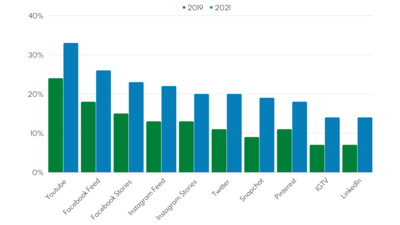
Let’s look at a few more statistics and metrics from Wyzowl’s latest Video Marketing Statistics:
-
87% of marketers say video has helped them increase traffic.
-
82% of marketers say video has helped them increase dwell time (the length of time a person spends looking at a webpage after they've clicked a link on a SERP page, but before clicking back to the SERP results).
-
94% of marketers say video has helped them increase consumer understanding of products or services.
-
86% of marketers say video has helped them generate leads.
-
81% of marketers say video has helped them directly increase sales.
-
49% of marketers say video has helped them reduce support calls.
-
93% of marketers say video has helped them increase brand awareness.
-
87% of marketers say video has helped achieve good ROI.
All great reasons to make video a must-have in your digital marketing strategy.
Why is Video So Effective?
But what exactly is it that video does to create these attractive benefits for your bottom line?
-
Video is one of the most popular types of content on social media, and that means it’s much more likely that your content will be shared by those who view it with their online friends.
-
Because of the boost that it gives to the overall quality of your website, video can significantly improve SEO.
-
Video is especially attractive and user-friendly for mobile users because of the ability to embed and tell captivating stories.
But despite the increased ease of creating video content, video marketing can still be a fairly intimidating beast. Factors like strategy, equipment, and editing software make for a learning curve that can give many marketers pause as they contemplate taking the video plunge.
Fortunately, though, according to HubSpot, consumers and customers have come to prefer lower quality, "authentic" video over high-quality video that seems artificial and inauthentic.
Yes, it can be intimidating to get in front of a camera. But remember: your content doesn’t need to be slick and flawless. It just needs to be useful and authentic.
A simple video comparing Drupal vs. WordPress CMS platforms illustrates how this genre of useful and authentic video content from industry professionals connects with a vast audience and helps reinforce your credibility.
11. Start a Podcast
Podcasts are the digital generation’s talk radio. And while people back in the day had to stay up late to listen to their favorite talk radio show, they can now listen, on demand, to any of over 132 million episodes of 2.8 million podcasts whenever and wherever they want.
And they do listen.
-
26% of Americans listened to podcasts in the last week.
-
Those listeners perused an average of 8 podcasts each week.
-
In 2019 22% percent of the podcast listening community listen to over 22 hours of podcasts a week.
-
35% listen to more than 10 different shows each month.
-
Thanks to easy access and the convenience of smartphones and personal assistants, podcasts can be enjoyed while driving, working, doing housework, jogging.
With topics ranging from music and the arts to health and fitness to news, history, science, true crime, and countless more, there’s something to satisfy pretty much anyone looking to make that daily commute a little more bearable.
What’s In It For You?
There are two ways you can take advantage of the podcast revolution in your digital marketing strategy.
Advertising
Podcasts are free, but they can generate huge profits via paid advertisements. And, with such a wide range of topics available, there’s bound to be a ready-made audience tailored to your demographics and waiting to hear your message.
By sponsoring or buying ad time in the right podcasts you can reach your ideal target audience and lead them directly to your website.
Advantages of podcast advertising include:
-
Less clutter: Despite the size and growth of the podcast audience, many companies have yet to take advantage of them. That means less competition for your advertising message to overcome to reach all those captive ears.
-
Precise targeting: We mentioned it above. Whatever your niche, there’s likely a podcast that reaches them.
-
Conversion: The average podcast offers an ROI of 242% on the dollar and a conversion rate of 34%.
-
Engagement: According to Media Village, “There is a level of focus among podcast listeners that enables advertisers to make an impact. IAB research shows 71% of podcast listeners report a high level of concentration; close to checking for news (76%) and weather (74%) and much higher than those watching shows and episodes (62%) or posting on social media (53%).”
-
Recall: According to IAB, 67% of listeners can recall a product feature or specific promotion mentioned in a podcast ad.
Creating Your Podcast
Launching a company or personal podcast combines the advantages of podcast advertising listed above with the advantages of publishing a blog.
With your own branded blog, you can establish yourself as an authority on any topic related to your business or host interviews with subject matter experts in your industry, all of which can make you the destination of choice for your target audience.
Podcasts can also lead listeners directly to your website where you can further engage with them. You can post transcripts of your podcast on your blog, which can boost SEO. You can share your podcasts on social media - and listeners can share them with their friends.
Podcasting requires little financial investment, and anyone can do it. And they can be recorded anywhere, from professional studios to an empty conference room down the hall.
Who Should Do This?
Whether through advertising or hosting original content, pretty much anyone can benefit from the podcasting revolution.
12. Host a Webinar
Social media does provide an opportunity for interaction between your brand and its audience, which is always helpful in terms of engagement, but webinar marketing is a way in which you can engage your audience online in real time. It’s an immersive and inexpensive form of online marketing, sharing many of the benefits listed for the other marketing channels mentioned above.
Once you lead your audience to the landing page promoting your webinar, those viewers or participants then become a part of your CRM and marketing automation platforms. These retention efforts help push participants through your nurturing and sales cycle as you continue the conversation to create customer loyalty.
More companies are choosing now, more than ever, to use some form of online information sharing as a marketing strategy. As you add new features to a product, online seminars (or webinars) are a very effective way to show them to customers.
Webinars allow customers and prospective customers to ask questions, just like an in-person demo or training session. They can be re-purposed and cut down into multiple parts for other online channels, and they’re a great way to have real-time Q & A while providing a more personal approach.
Who Should Do This?
In general, it’s the bigger businesses that will benefit most from the use of webinars. If you don’t have a large enough audience, the opportunity for an informative Q&A is sacrificed. In the case of smaller anticipated audiences, your business will generally benefit just as much from pre-produced video marketing as opposed to a live presentation.
13. Get on Google Maps
Google Maps has become much more than just a convenient way to save you from driving in circles while navigating unfamiliar territory. It’s now evolved into a powerful marketing tool for your business.
With Google being the most visited website and claiming ownership of a substantial share of the search engine market, it’s become one of the most powerful ways for you to attract new customers and increase conversions significantly.
What is Google Maps Marketing?
Google Maps is, of course, a navigation tool. It’s the best way for consumers to find directions to your location. Google maps marketing demo places turn-by-turn directions to your front door literally in the palm of their hand. And you can make things even easier by installing a store locator on your site to help lead customers directly to your physical destination.
But Google Maps isn’t just for guiding the way. A Google My Business profile lets you control and updates or important online details about your business. Contact information, business hours, and much more can always be kept accurate and at the fingertips of prospective customers without having to rely on possibly outdated info from third-party sites.
Finally, Google maps Marketing also helps build your credibility and reputation with customer ratings and reviews as shown in the example below.
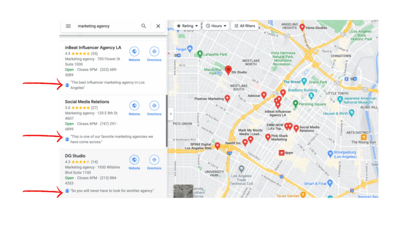
Google Maps Pointers
There are several steps you can take to maximize the benefits that Google Maps can offer:
-
Verify your location to ensure customers can easily find you.
-
Build a complete Google Business Profile with the appropriate keywords to improve your ranking in Google search results.
-
Include high-quality pictures and videos to highlight your team, products, and services.
-
Encourage customers to leave ratings and reviews.
-
Respond to ratings and reviews. Yet another example of how customers value and are influenced by the opportunity to interact with you online.
Perhaps most importantly, though is the fact that Google Maps Marketing is not just easy to use. It’s also free. And you’d be hard-pressed to find a better marketing value than that.
14. Be Local
Local marketing is a marketing strategy that targets your message to consumers within a local radius of your business location(s). It’s also known as neighborhood or local store marketing.

Local marketing is a useful tool for any brand with a physical location or whose primary business happens in-person as opposed to online. It allows you to pinpoint your resources toward a select target audience that can respond to and shop in the place that you call home.
-
Confirm your website is mobile-friendly. use Google's Mobile-Friendly Test tool to make sure you’re reaching the 61% of mobile searchers who say they’re more likely to contact a local business when it has a mobile-friendly site.
-
Invest in local SEO. Use Google Trends to identify what terms are popular in your location and for your industry, and use those terms on your website and in your content.
-
Localize your website. Make sure your web content remains relevant to your local audience by adding location-based terms to your content. Localize your website and paint yourself as a local authority by promoting local gatherings, neighborhood events, and more relevant information from your area.
-
Be active in your community. By taking a true interest in your community and remaining an active participant in and/or sponsor of local events, non-profits, sports teams, and more, you increase the chances of your brand being associated with the things your local community cares about.
-
Get listed on third-party websites and directories. Like Yelp, Yellow Pages, Better Business Bureau (BBB), Foursquare, and more
-
Go local on social media. Whether it’s setting a location in your profile or tagging the location of individual posts, social media is one of the most efficient ways to reach both local and global shoppers.
15. Run Giveaways
Giveaways are a unique but effective digital strategy as part of your digital marketing plan. An effective giveaway can be easily carried out via social media to increase brand awareness and excitement while also generating new followers.
The best giveaways are simple giveaways. Don’t make your consumers jump through a lot of hoops to win. A simple share or post to your story should be all it takes to win a chance at free products or services.
16. SMS Marketing
SMS marketing is just what it sounds like. It’s the practice of sending marketing messages by text message.
Like email, SMS marketing is a form of opt-in marketing. That means contacts must subscribe to be fair game in your marketing hunt.
Common types of SMS marketing messages include:
-
personalized promotions
-
offers or discounts
-
remarketing
-
surveys
These messages are distinct from another form of SMS communication: SMS customer service.
As digital marketing channels expand, consumers are becoming increasingly comfortable interacting with businesses via mobile devices. In many cases, they expect businesses to be reachable by messaging or text. And, while it’s not marketing per se, SMS customer service can be a great way to more conveniently meet your customers’ needs, and that makes for more a loyal clientele.
A few types of SMS customer service messages include:
-
order confirmations
-
dispatch notifications
-
tracking information
-
delivery updates
In addition, more and more companies are offering direct one-to-one texting between customers and customer service agents to answer questions, place orders, and perform any number of other tasks that might otherwise be handled by email or phone.
As of 2020, 56% of U.S. retailers planned to increase their digital marketing investment in messaging and SMS. It’s a marketing technique that will continue to grow for the foreseeable future. But don’t think you can just jump into the pool and start texting everyone for whom you’ve got a phone number.
As mentioned above, SMS marketing should only be an opt-in form of communication, and each message should give the consumer instructions to opt-out.
17. Content Marketing
Whether it be articles, videos, podcasts, infographics, or other media, content marketing is a vital marketing strategy used to engage, attract, and retain an audience by creating and sharing relevant pieces of content that connect with consumer pain points and questions.
We’ve outlined the advantages of a variety of content above, so we won’t discuss them here. Suffice it to say that content marketing is a growing digital marketing trend. And you can expect its growth to continue for some time to come as marketing channels expand.
18. Brand Partnerships
Brand partnerships are a great option for your digital strategy. They’re a technique that allows for a more “local community” to familiarize themselves with your marketing efforts.
A brand partnership is an agreement between two or more businesses, brands, or organizations. As a result of these partnerships, each member benefits from breaking into new markets, increasing brand exposure and adding value to their respective products and services.
Successful brand partnerships can benefit everyone involved by:
Building Trust: When your brand partners with another trusted brand, that brand’s consumers can feel more confident that they can also trust you. Here, the goal is to build by association. This is one of the easiest and most trusted ways to reassure consumers that you are a reputable brand.
Add Value: A well-integrated partnership adds intrinsic value to each brand’s product or service. With two or more stakeholders involved, each brings something unique to the table. As a result, consumers find extra value in each partner’s offerings.
Generate Buzz: A partnership between reputable brands creates buzz that encompasses each brand, exciting consumers and providing public relations opportunities and media exposure for all.
Remember, though, that not all national brand partnerships are created equal. Both companies must gain something from it, and the brands must formulate a cohesive marketing campaign that makes sense to the consumer. At O8, we leverage the following brand partnerships to deliver the best possible solutions.

19. Affiliate Marketing
Affiliate marketing is a popular digital strategy that is often overlooked by many brands as they formulate their marketing strategies. Many businesses don’t consider affiliate marketing. But they should.
Affiliate marketing is a process that allows publishers to earn a commission by promoting the products or services of another retailer or advertiser. The affiliate partner receives a payout for providing a specific result to the promoted retailer or advertiser.
It generally involves referring to a product or service by sharing it on a social media platform, blog, website, or podcast. The affiliate earns a commission with each purchase made through the link associated with their recommendation.
20. Partnering with the Right Digital Agency
Digital agencies provide an array of services that can help ease the load for overwhelmed and overburdened marketing departments, especially in medium to large companies where the flow of different tasks is continuous.
There are several ways to address the issue of burnout among marketers, but the best and most cost-effective way is simply to hire out some of the workload.
The products offered by agencies can range from web development and design to all the different aspects of digital marketing, which is why, if they are to be included in the overall strategy, it is imperative to sit down and examine which areas the company needs real assistance with.
Choosing the right marketing or web design agency is a delicate process, one which should not be taken lightly because of the impact it will have on your company’s overall digital performance.

